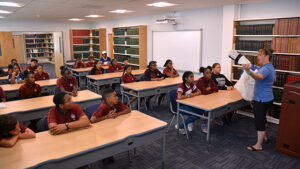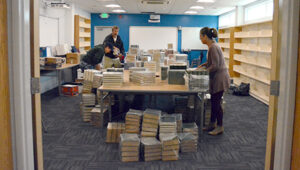BIOS Library Renovation Offers a “Fresh, Energized” Space

Program assistant for Ocean Academy, Kyla Smith, demonstrates a plankton tow net for visiting students from Dellwood Middle School.
In recent years, libraries in North America have become much more than book repositories, providing modern classrooms and light-filled lecture spaces, comfortable group and individual study areas, and high speed Internet access. The newly renovated library at BIOS promises that and more—anyone want to learn to build a circuit for an undersea robot?
The E.L. Mark Library, which re-opened in May, is a modern, 1,700-foot study space and teaching facility. The renovation, funded by the Allan Gray Trust, increased accessible space primarily by removing stacks of underused documents in the library portion and opening two adjacent rooms for additional group collaboration. Smaller spaces within these rooms will cater to researchers and students with a need for quieter study areas.
The updated design and furnishings reflect the Institute’s commitment to patron comfort and energy efficiency. Windows allow natural light and students, staff, and visiting scientists now study and read under energy-efficient lighting. They also have access to smart board projectors and teleconferencing capabilities. Electrical upgrades, housed in the floor, provide high-speed data transmission that links users to outside libraries and universities.
“We already had high-quality teaching, and now we have another high-quality teaching environment,” said Andrew Peters, education director for university programs at BIOS. Peters said he was particularly impressed by the flexible learning opportunities within the renovated space, which is adaptable for individual study or group collaboration. “This will only enhance our ability to provide a world-class experience for visitors,” he said.
The renovated space continues to support the library as a repository of about 3,000 reference books and science journals, which now line bookshelves on exterior walls, as well as shelves in an adjacent conference room.
To determine what materials would be kept (and what duplicates could be found online), dedicated BIOS staff and an intern began contacting librarians across North America in the summer of 2014 for input into the value of the Institute’s existing library collection, estimated at nearly 10,000 items. The sorting process culminated in 2016 with careful consideration of library holdings by BIOS library manager Heidi Smith, along with former colleagues Chloe Baron and Penny Barnes.

BIOS staff members (from left) Heidi Smith, Peter Flook, and Miranda Medeiros unpacked materials that were stored during the renovation. The renovated space offers teleconferencing abilities and high speed access to online materials, yet continues to support the library as a repository of about 3,000 reference books and science journals.
Materials intended for continued use at BIOS—primarily reference books and journals— were wrapped and stored during the renovation. The remainder, which can be found through searchable online databases, were donated or recycled to maximize the renovated space. Smith said she hopes that remaining library materials at BIOS will be scanned and made available online, particularly historically significant items.
Among the library’s most significant holdings is one of the few remaining and complete 50-volume sets of the report of the famed HMS Challenger expedition, a four-year-long global circumnavigation in the 1870s that provided the foundation for oceanography. The library also houses the collection of 1,783 peer-reviewed, scientific publications from research conducted at BIOS during its first century of operation, beginning in 1903.
The E.L. Mark library originally opened in 1947, one year after the death of its namesake, Edward Laurens Mark. Mark, a Harvard professor and a founder of the Institute—as well as its first director—served as chair of the library committee until he died. Fiercely dedicated to the Institute’s research and mission, he was known to personally reorganize the library’s entire catalog of journals during his visits to Bermuda.
The library expanded its offerings over later decades but, since 1971, little had changed about its layout, features, or furnishings, said Kevin Hollis, the facilities manager at BIOS who oversaw the renovation. In recent years, the renovation became part of an ongoing effort to modernize facilities on the BIOS campus, and involved the expansion and consolidation of several existing spaces on two floors in the heavily utilized Redfield building.
The project included reconfiguring a portion of Redfield’s first floor. The Riker room, a traditional classroom, was expanded and relocated next to the library, for use as a lecture space or, as needed, for a computer lab. The renovation also included relocating the Sunderman conference room from the second floor to the first, where it will now serve as a classroom and video conferencing location.
The renovated facility is located adjacent to the high-tech Mid-Atlantic Glider Initiative and Collaboration (MAGIC) Room, which was completed in 2016 to facilitate data analyses, scientific collaboration, and learning among students and visitors from Bermuda and abroad. The room offers a large, multi-screen display used to project course material and help visualize global oceanic and atmospheric patterns.
The additional renovated library spaces will be invaluable to BIOS’s visiting groups and related programs, said BIOS educator Kaitlin Noyes. “We expect that hundreds of students from grade schools, high schools, and universities will use this space during their visits each year,” she said.
Open to the general public, the BIOS library serves as the main scientific library on the island, though the majority of patrons are staff and students. Additionally, “we host roughly 35 groups a year, from the island and internationally, and we know they will actively use this space for lectures, presentations, and group brainstorming sessions,” Noyes said.
Increasingly, technology is used for investigations that encourage students to tackle real-world oceanographic challenges; for example, how to build and manipulate underwater robots to access deep, remote areas of the ocean, or along valuable and threatened coral reefs located just miles from the BIOS campus.
The library and its adjoining spaces represent a chance to expand teaching opportunities, she said.
“Building circuits, learning to code, learning to solder and waterproofing are all skills we want to offer, to complement traditional lectures and library research,” Noyes said. “How wonderful that we can provide our visitors and staff these opportunities in this fresh, energized space.”
